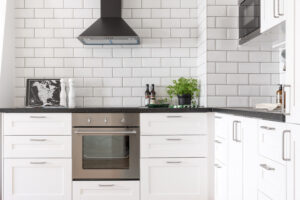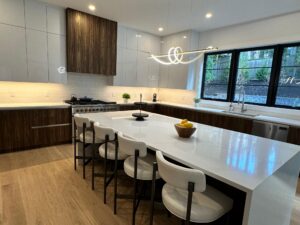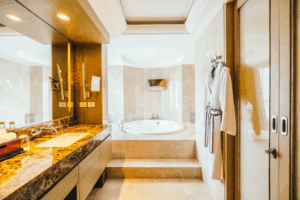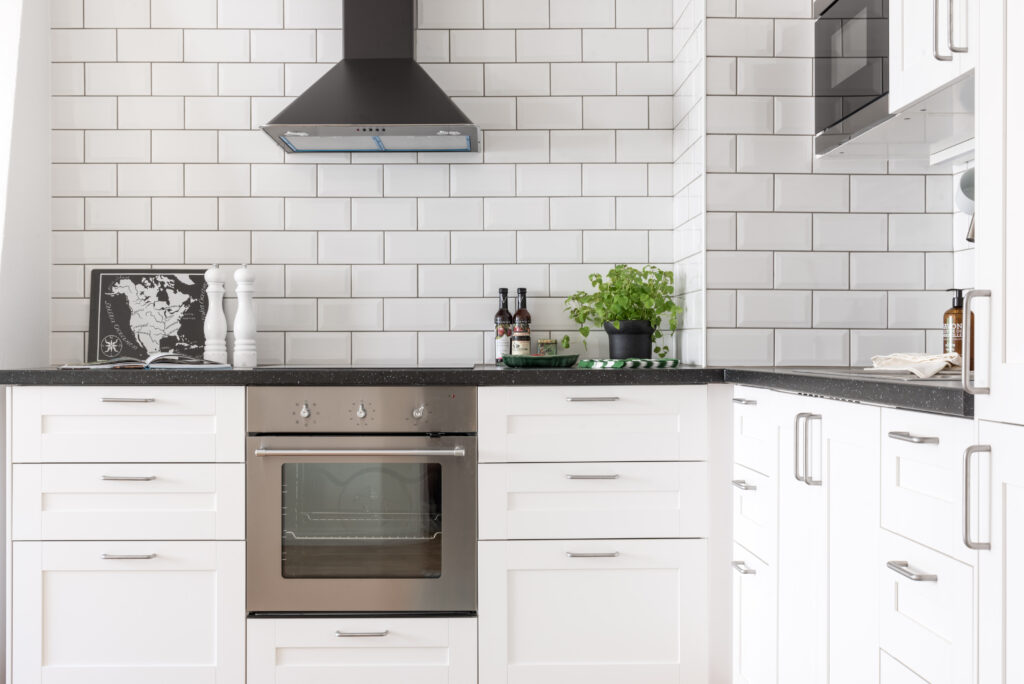
The relationship between countertop and backsplash combinations defines how a kitchen or bathroom looks and functions. More than matching colors, this choice influences balance, proportion, and how the space connects visually.
A well-executed combination creates harmony, adds texture, and highlights key elements of the design. Poor alignment between materials can overwhelm the layout, disrupt flow, or make the space feel unbalanced.
This guide explains how to approach countertop and backsplash combinations with the precision and confidence of a design professional. Keep reading to understand how to balance contrast, align textures, choose complementary tones, and create a result that feels cohesive.
Why the right countertop and backsplash combinations matter
The countertops and backsplash combinations define the kitchen or bathroom’s visual structure. These elements work together to create flow, contrast, or cohesion. For this reason, the design’s success depends on how well planned this relationship is.
The countertop is the dominant surface in most spaces. Its color, pattern, and texture set the foundation for how the room feels. The backsplash, while physically smaller, is essential in framing the space and creating visual transitions between the countertop, cabinetry, and wall.
When materials and tones are thoughtfully paired, the design feels balanced. A highly patterned countertop, for example, benefits from a backsplash that offers subtle texture or solid tones, preventing visual competition. On the other hand, clean and minimal countertops pair well with bolder backsplash designs that introduce movement or pattern without overwhelming the room.
Ignoring this balance leads to designs that feel chaotic or disconnected. Too much contrast can feel harsh. Too much similarity can flatten the space, making it feel uninspired.
Beyond appearance, this pairing impacts functionality. Both surfaces need to withstand moisture, heat, and daily wear, while complementing the cabinetry, flooring, and overall architecture of the space.
Well-chosen countertop and backsplash combinations elevate the entire design. They provide clarity, sophistication, tying the space together, and creating a complete result.
Balance or contrast? Finding the right approach for countertop and backsplash combinations
Choosing between balance and contrast is one of the first decisions you’ll need to face when selecting countertop and backsplash combinations.
Both approaches work, but the right choice depends on the mood, functionality, and style you want the space to express.
Balance
A balanced combination focuses on creating a seamless, harmonious look. This involves selecting materials in similar tones, complementary textures, or subtle variations within the same color family.
For example, a soft gray quartz countertop pairs effortlessly with a light gray, matte-finish backsplash. This approach creates continuity, making the space feel calm, elegant, and timeless.
Balance works well in minimalist kitchens, contemporary bathrooms, or spaces designed to feel open and uncluttered. It allows cabinetry, lighting, and architectural details to stand out without competing with bold surface patterns.
Contrast
Contrast in countertop and backsplash combinations creates a focal point. It introduces depth, texture, and energy to the design. A marble countertop with bold veining, for example, can be paired with a simple white subway tile backsplash to let the stone become the centerpiece. Alternatively, a white countertop can be a neutral base for a bold, geometric tile backsplash.
Contrast works when the goal is to add personality, movement, or highlight a feature within the space. It requires thoughtful execution. The key is allowing one surface to lead while the other supports.
How to decide between the two
Consider how the space is used. High-traffic family kitchens benefit from balanced designs that feel cohesive over time. Entertainment spaces or statement kitchens may favor contrast to create a more dynamic impression.
Lighting is also a key element in creating the desired feel. Well-lit spaces handle darker contrasts easily. Smaller or lower-light rooms benefit from balanced, lighter tones to avoid feeling heavy.
There is no universal formula. The right decision comes from understanding how countertop and backsplash combinations influence how a space looks and how it feels and functions day to day.
Material selection in countertop and backsplash combinations: Matching texture, pattern, and color
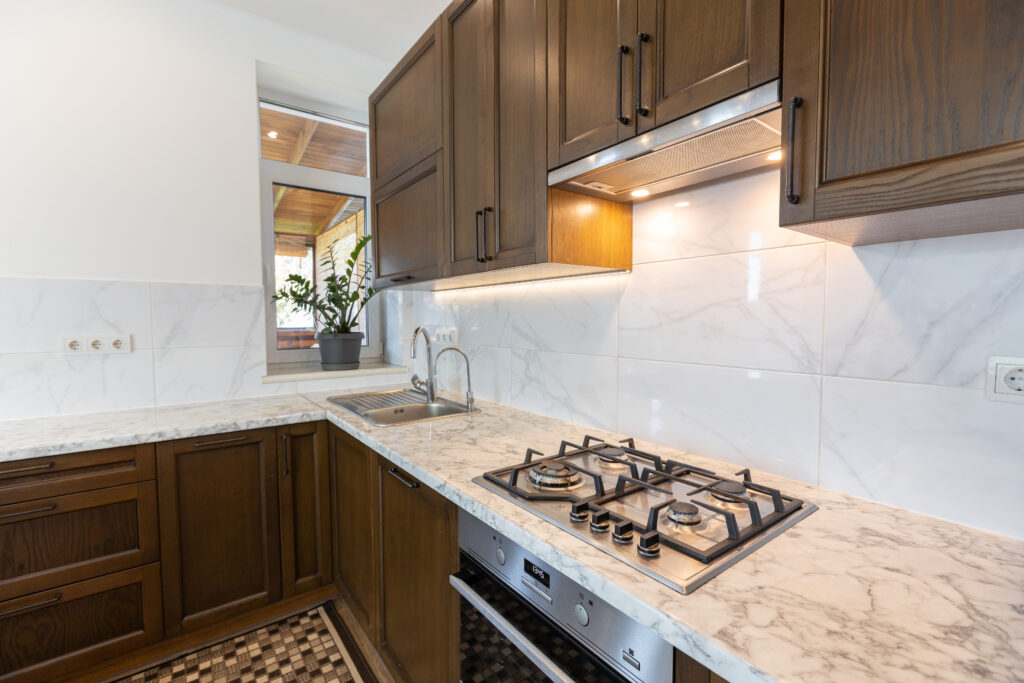
Texture, pattern, and finish are equally important in creating a balanced, sophisticated design.
Texture: polished, matte, or tactile finishes
The texture of each surface influences how light interacts with the space. A polished countertop reflects more light, adding brightness and a sense of refinement. Pairing it with a matte backsplash introduces softness and balance, preventing the space from feeling overly glossy or clinical.
For more organic or contemporary designs, combining honed or leathered stone with textured backsplash materials like handmade tiles, brushed ceramics, or natural stone adds dimension without overwhelming the design.
Pattern: subtle or bold, but never competing
The countertop and backsplash combinations between patterns define the visual flow. If the countertop has veining, movement, or a strong grain, the backsplash should stay understated. Select solid tones or subtle textures to prevent visual competition.
Conversely, a minimalist countertop in solid white, black, or light gray creates the perfect backdrop for a backsplash with geometric designs, mosaic patterns, or rich tonal variations.
A common mistake is pairing two high-variation surfaces, which can cause the space to feel chaotic or fragmented. One surface should lead visually, while the other complements.
Color: tone-on-tone or complementary palettes
Color selection depends on whether the goal is harmony or contrast. Tone-on-tone designs use varying shades of the same color family.
For example, pairing a white quartz countertop with a warm white, cream, or light gray backsplash. This creates subtle depth without harsh divisions.
Complementary palettes introduce controlled contrast. A charcoal countertop combined with a soft taupe backsplash balances dark and light without creating sharp tension.
Natural stone, quartz, and porcelain offer flexibility in both color and pattern. The key is evaluating samples together, in the same lighting conditions as the finished space, to ensure they complement rather than clash.
Material selection is not just about choosing beautiful surfaces. It’s about understanding how texture, pattern, and color influence mood, proportion, and balance — resulting in a kitchen or bathroom that feels cohesive and visually grounded.
Common mistakes to avoid when making countertop and backsplash combinations
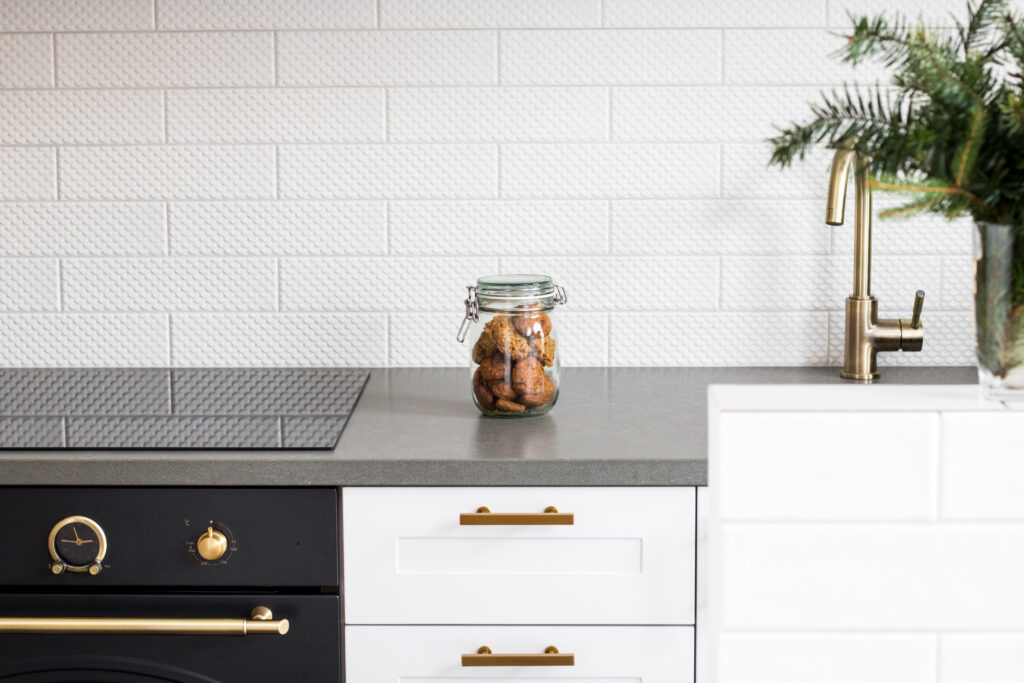
Avoiding a few common mistakes ensures that the design feels intentional, balanced, and timeless.
Overmatching patterns
One of the most frequent mistakes in countertop and backsplash combinations is pairing materials that have bold patterns and heavy veining. This creates visual noise, making the space feel chaotic and overwhelming.
If one surface has strong patterning, the other should remain subtle, offering a clean and supportive backdrop.
Ignoring undertones
Not all whites, grays, or beiges are the same. A countertop with cool gray undertones can clash with a backsplash that leans warm, creating an imbalance that feels off but is hard to immediately identify.
Always evaluate samples side by side, paying close attention to undertones in natural and artificial light.
Misaligned finishes
Pairing two polished surfaces can sometimes create too much glare or a sterile feeling, especially in kitchens with abundant natural light.
On the other hand, combining two completely matte surfaces may result in a flat or heavy appearance.
The solution is balance. Pairing polished stone with a matte or textured tile or combining a soft honed countertop with a glossy ceramic backsplash can be a great option.
Choosing trendy combinations over timeless ones
Design trends shift quickly. A backsplash with highly decorative patterns or bold colors may look current now but can feel dated within a few years.
Investing in timeless countertop and backsplash combinations, with classic materials like marble, quartz, granite, or subtle tile designs, ensures aesthetic and functional longevity.
Overlooking scale and proportion
The scale of patterns matters. Large, sweeping veining on a countertop may not pair well with small, intricate backsplash tiles.
Pay attention to how the scale of each surface relates to the size of the kitchen or bathroom. Smaller spaces benefit from tighter, more consistent patterns, while larger spaces can handle bigger contrasts.
Avoiding these mistakes means understanding how countertop and backsplash combinations influence balance, flow, and the overall feel of the space. Working with experienced material consultants ensures these decisions are made with clarity and precision.
How Classic Stoneworks helps you create perfect countertop and backsplash combinations
Selecting countertop and backsplash combinations is a decision that impacts how a kitchen or bathroom looks and how it functions over time.
At Classic Stoneworks, this process is guided by expertise, precision, and an understanding of how materials interact in real spaces.
Tailored design consultation
Every project starts with a personalized consultation. Our team takes the time to understand the client’s style preferences, how the space is used, and the architectural elements that need to align.
We select materials that support the exact mood and functionality the client expects from the space.
Material curation with clarity
With hundreds of stone slabs, quartz patterns, and tile options available, it’s easy to feel overwhelmed. Our role is to make the choosing process easier. We curate material options that align with the project’s goals, narrowing choices based on color harmony, texture compatibility, and pattern balance.
Clients can view full slabs, not just samples. This ensures that veining, tone variations, and texture are fully understood before any decisions are finalized.
Precision fabrication with pattern matching
Veining alignment is critical for countertop and backsplash combinations. Our fabrication process considers this, ensuring that seams are minimized, patterns flow naturally, and the aesthetic remains uninterrupted.
The same precision applies to backsplash layout, where grout lines, tile cuts, and spacing are all planned.
Full-service installation with quality control
Installation is more than placing surfaces. Our in-house team manages every step, from delivery to final detailing.
Counters are leveled, seams are calibrated, and backsplashes are installed with attention to alignment and proportion. The result is a finish that looks seamless and feels professionally executed.
Choosing Classic Stoneworks means having a team that understands the technical and aesthetic demands of high-end design. Every decision is supported by expertise, ensuring that your countertop and backsplash combinations enhance the space for years.
Choose your countertop and backsplash combinations for a space that feels cohesive, balanced, and timeless
Pairing the right countertop and backsplash combinations is one of the most important decisions in kitchen and bathroom design. This choice defines how the space flows, how materials interact, and how the environment feels.
When surfaces are selected thoughtfully, every detail works in harmony. The textures, tones, and patterns complement one another instead of competing for attention. Function aligns with beauty, creating an environment that supports daily routines while reflecting personal style.
At Classic Stoneworks, our approach goes beyond simply supplying premium materials. We guide every step of the process, simplifying complex decisions and helping clients achieve results that elevate the space’s looks, functionality, and longevity.
Well-executed countertop and backsplash combinations have the power to transform a kitchen or bathroom.
Ready to bring your vision to life?
Contact Classic Stoneworks to schedule a consultation and explore how we can help create a space where every surface feels perfectly aligned.
For design inspiration, explore these curated kitchen and bathroom projects.

